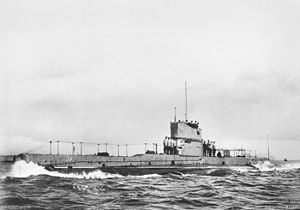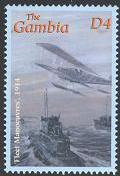|
The British E class, workhorse of the British submarine force during WW-I
 The design was based on the D class design, saddle tank type, but modified to include broadside 18" torpedo tubes. There was also an increase in displacement (length and beam), surface speed and endurance and submerged horsepower of main electric motors. The design was based on the D class design, saddle tank type, but modified to include broadside 18" torpedo tubes. There was also an increase in displacement (length and beam), surface speed and endurance and submerged horsepower of main electric motors.
The design incorporated also, for the first time, two internal watertight bulkheads dividing the boat to three compartments adding substantial survival ability.
Specifications, HMS E-1, E class:
Keel laid down by Chatham Royal Dockyards (as Ex D-9), launched on November 9, 1912
Displacement (srf/sub tons): 655/796
Dimensions (L*B*D feet): 178`1*22`6*12`6
Propulsion: 2*800hp 8-cylinder Vickers diesel engine, 2*420hp electric motors for submergence driving two shafts
Speed (srf/sub knots): 15/10
Range (srf/sub n/miles@knots): 3,000@10/100@3
Diving depth (feet): 100
Complement: 3 officers 28 enlisted
Torpedo: 1*18" bow torpedo tube, 2*18" broadside, 1*18" stern torpedo tube, containing a total of 8 torpedoes
Mines: none
Armament: Although not fitted to early boats during construction all boats were armed with a deck gun from 1915 onwards. The standard mount was a 12pdr but other types were fitted.
Construction
The 48!! submarines of the E class were launched between 1912 and 1916. They were of three groups. Groups 2 and 3 underwent some design modifications in hull, dimensions and displacement, changes in general arrangement and adding a second bow torpedo tube.
Two submarines of this design, AE-1 and AE-2, were built, for the Royal Australian Navy.
Six boats, E-24, E-34, E-41, E-45, E-45, E-51, were constructed as minelayer, in these boats 20 vertical tubes were mounted in the side ballast tanks replacing beam torpedo tubes.
Back to History Index
 |
Gambia, The |
2001 |
The Royal Navy fleet manoeuvers 1914.E class submarine |
|